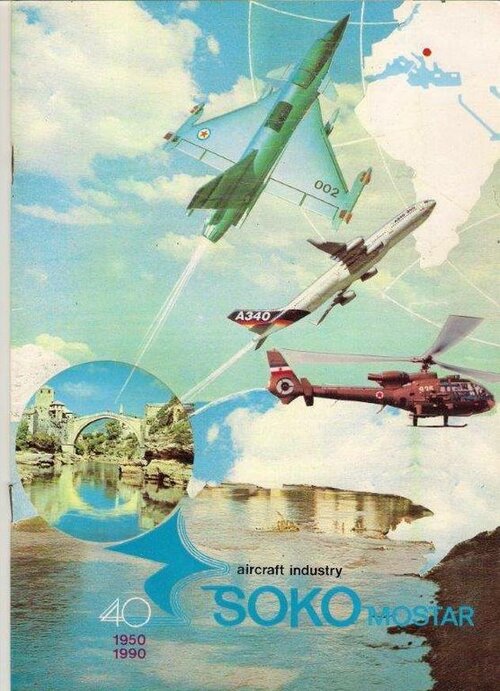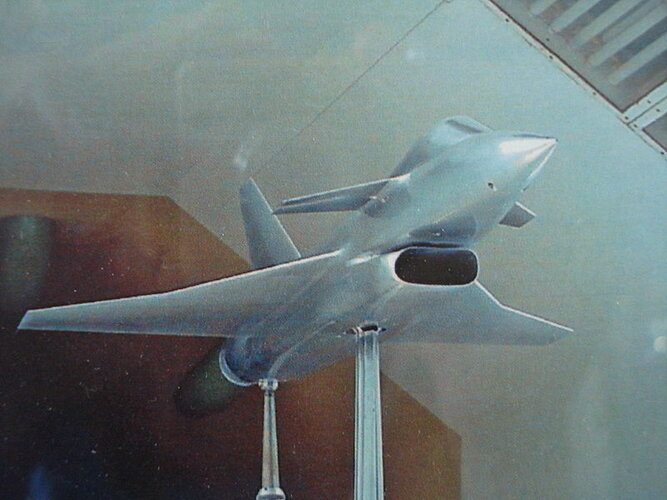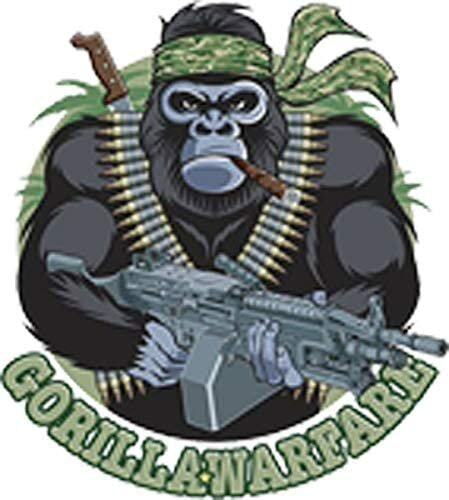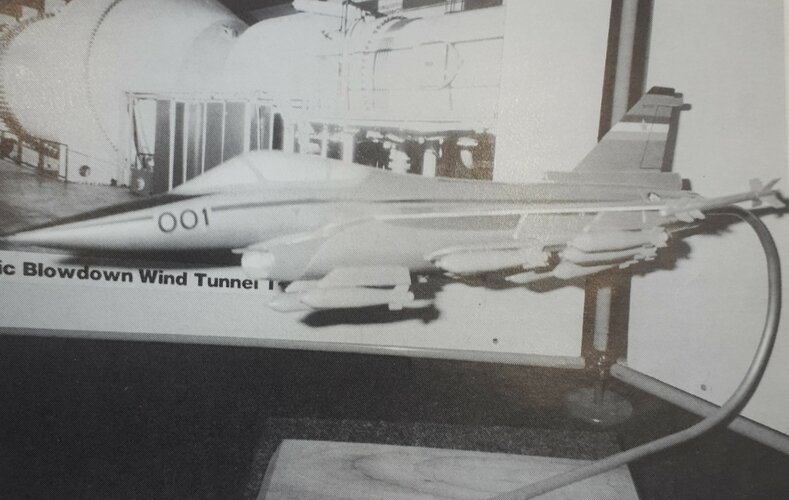You are using an out of date browser. It may not display this or other websites correctly.
You should upgrade or use an alternative browser.
You should upgrade or use an alternative browser.
Novi Avion / YU Supersonic (Yugoslavia)
- Thread starter overscan (PaulMM)
- Start date
- Joined
- 26 May 2006
- Messages
- 32,689
- Reaction score
- 11,918
Attachments
- Joined
- 27 December 2005
- Messages
- 16,455
- Reaction score
- 19,155
If a Rafale kit ever existed in 1/96 scale, it would be a perfect basis to model a 1/72 Novi Avion... because that thing looks amazingly like a 2-3rd downscaled clone of a Rafale, except with one engine.
To the point they kept the exact same intakes even with only one engine...
To the point they kept the exact same intakes even with only one engine...
Vodlan offered a 1/72 scale model of Novi Avion a few years back, but they are difficult or impossible to find on the second-hand market.
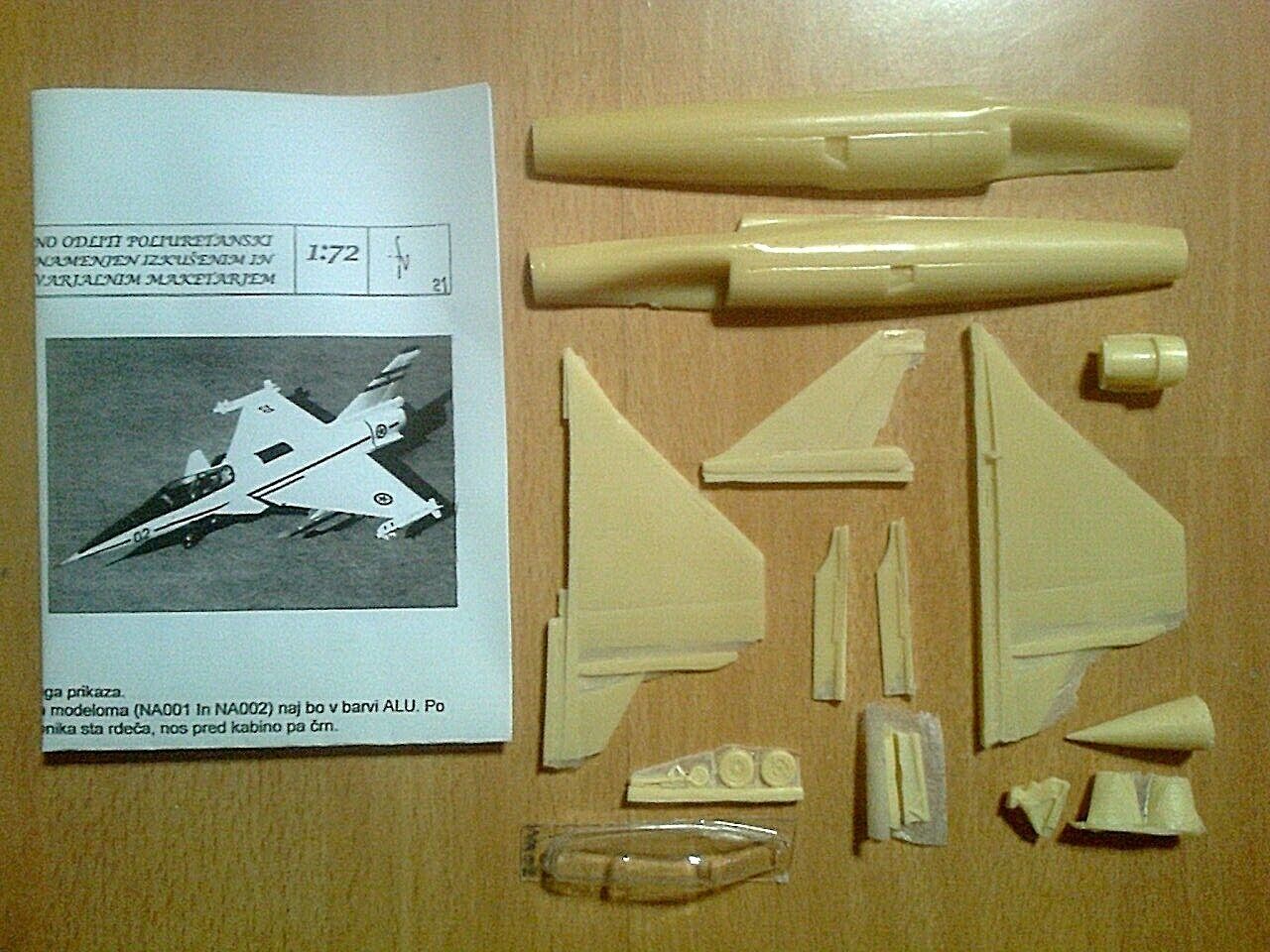
F-2
ACCESS: Top Secret
- Joined
- 22 May 2020
- Messages
- 694
- Reaction score
- 1,211
From that same presentation a look at the Flight simulatorSmall presentation in English of the wind tunnels built for the testing of Novi Avion
F-2
ACCESS: Top Secret
- Joined
- 22 May 2020
- Messages
- 694
- Reaction score
- 1,211

RBE2 radar gets ahead
The RBE2 radar - a European pioneer - is set to be among the first airborne multirole electronically scanned radars in the world to be introduced into service Julian Moxon/PARISThe Rafale's RBE2 (radar à balayage electronique/2) multirole electronic scanning radar is the first of its type to be...
RBE2 is capable of supporting semi active missiles. I don’t think it ever has on the Rafale but it could be an option hear. PESA is pretty useful for SAHR and I believe RBE2 has LPI.
- Joined
- 27 December 2005
- Messages
- 16,455
- Reaction score
- 19,155
Attachments
- Joined
- 27 December 2005
- Messages
- 16,455
- Reaction score
- 19,155
Baptism with whiskey and brandy
During the development of the conceptual design of the supersonic aircraft, negotiations were held in parallel with the French company "Marcel Dassault" and the British "British Aerospace" .
Draft agreements on cooperation and provision of technological support were made. This was done with the intention of signing contracts and achieving double cooperation, but only in the phase of working on the conceptual design. The idea was to make as many possible variants of the conceptual solution as possible in order to create a competitive relationship between these companies until the conclusion of the main contract. This enabled our side to choose a more favorable offer at the last minute.
The management of the Aeronautical Technical Institute from Žarkovo, together with other experts in the Yugoslav aviation industry, on the one hand, and representatives of potential strategic associates, the French "Marcel Dassault" (in one option) and the British "British Aerospace" (in the other), met with all the capacities and readiness to produce a new aircraft.
According to the memory of General Sava Pustina, serious work on the design of the National Assembly began after the former chief engineer of the French company "Marcel Dassault", Mr. Gerard, arrived in Belgrade from Paris. His task was to assess the possibilities of the Institute and the entire Yugoslav aviation industry in developing a supersonic aircraft program. A detailed tour of all capacities was organized. The procedure was repeated with the representatives, and the same was done for the experts of "British Aerospace" from Britain, which was led by Mr. Fletcher, the head of the development of advanced aviation technologies.
During a tour of the Soko factory in Mostar, where domestic aircraft were assembled, Mr. Gerard did not hide his satisfaction with what he saw. When he visited the plants of the "First Five-Year Plan" in Trstenik, he literally did not believe what he saw.
- If I had died yesterday, I would not have believed that the Yugoslavs have such modern plants - said the Frenchman, claims General Pustinja.
- Mr. Gerard then warned our aviation experts that they must set aside production lines in "Petoletka", where parts for aircraft are made, in separate halls, in relation to the lines of production of parts for other combat means. Different types of production and technologies must not be in the same hall and in the same space. According to Gerard's explanations, aviation technologies do not suffer the slightest mistake or tolerance for omission, nor the presence and influence of more liberal regulations and standards.
Mr. Fletcher, as a man who was more inclined to research and development, was especially impressed with the Institute in Žarkovo, its professional staff and its equipment. He easily and quickly established contact with our experts, and soon some friendships were made. In these encounters, a kind of traditional little ritual was created. On each arrival, at the first meeting, he brought a bottle of quality whiskey. Before the beginning of those meetings, he took out that bottle of whiskey on the table, and Colonel Branko Kuzmanović took out the prepared bottle of his homemade brandy. The "barter" came first, and only then did the working part of the meeting begin. The bottle with Kuzmanović's brandy was not opened, Fletcher took it home.
After the information was exchanged and the available capacities were exchanged, official parallel talks began with both of these companies from France and Britain on contracting joint work on the new NA project. The French insisted on a system of work with a permanent project bureau stationed in Paris, in which every French expert would have one colleague from our side. An agreement was made with the English for partial joint work at the Institute in Žarkovo, according to certain agreed areas, where solutions would be harmonized and further activities would be agreed upon. Both concepts of work have been officially agreed and the texts and conditions of the contract have been harmonized in accordance with them.
Finally, two contracts were signed with the French and the British for the development of a preliminary design for the NA, in cooperation with experts from the Aeronautical Technical Institute. The agreements stipulate that this joint, parallel work on drafting the solution will last for six months. This part was successfully realized within the agreed deadline. The results obtained in the development of the conceptual design unequivocally indicated that the NA project will meet all technological, technical and tactical requirements, but also that many of the required characteristics have been exceeded.
Based on the obtained results of the conceptual design, all technical and economic analyzes and other relevant data, in June 1986, the Institute prepared a detailed and comprehensive Implementation Program (PR), in three voluminous books, plus abbreviated summaries. The implementation program was fully adopted at all army levels, and the conclusion was to propose to the competent state authorities to make a decision on agreeing to continue cooperation on the implementation of all subsequent phases of the NA program, with the French company "Marcel Daso". The production of 200 planes for our air force and the potential export of several hundred aircraft is planned. The possibility was left for the eventual French Air Force to decide on the introduction of that aircraft into its operational use.
Finally, in 1988, during the harmonization of the texts of the agreement for the continuation of cooperation, the British government decided that their country could not sell technology to another country younger than seven years. This move by London immediately excluded the British firm from the race for further negotiations. In the same year, the NA project was evaluated at the state level of the SFRY and was evaluated as "excellent". Economists from the Federal Executive Council, however, warned the army that "there is not enough money" as required. They were told that the army would give up some other things. The military budget has not changed, the redistribution of funds has changed, with the priority of financing the supersonic plane.
The Yugoslav supersonic aircraft NA was a great technological and scientific step forward in relation to all previous domestic projects. In short, it was envisaged that the construction of the aircraft structure would be made of composite and other advanced materials. The entire wing, except for the fittings, is made of carbon fiber composites, about 40 percent of the total "wet" surface of the aircraft. The hull structure would be mainly made of aluminum-lithium alloys, and the elements that suffer from high specific loads from titanium and steel. Superplastic molding technology would be applied to a significant extent to parts of complex shape, with high specific load-bearing capacity (such as the attack and exit edge of the "rock" and the wing). New diffusion welding technology would also be introduced.
These technologies would be primarily adopted and introduced in the factories "Soko" in Mostar and "Utva" in Pancevo, which were programmed for the production of NA aircraft structure assemblies. It was also planned to transfer part of the production of engines, radars and all other NA aircraft systems to our factories, which would be a fantastic technological step forward for the entire Yugoslav industry.
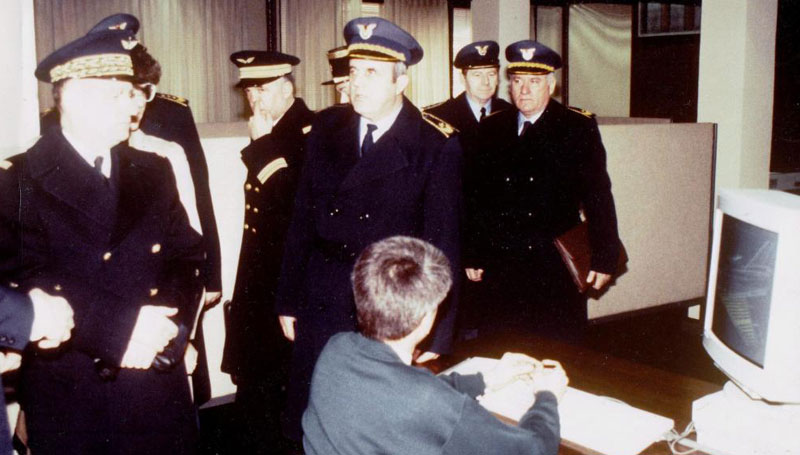
Krštenje uz viski i rakiju
U toku izrade idejnog projekta nadzvučnog aviona paralelno su vođeni pregovori sa francuskom firmom “Marsel Daso” i britanskom “Britiš aerospejs”
Last edited:
- Joined
- 27 December 2005
- Messages
- 16,455
- Reaction score
- 19,155
A new vision of a fighter hunter
At the Institute in Žarkovo, a compromise was made between the research freedoms of engineers and the rigor of aviation technology. The SFRY is the fifth country in the world to produce electric commands

COLONEL Branko Kuzmanović, at the time of designing the supersonic plane, was the chief of construction at the Aviation Technical Institute in Žarkovo. His task was to organize the acceptance of harmonized solutions from the offices in Paris and Belgrade in Belgrade, and to incorporate these solutions into the documentation of the supersonic aircraft within the service he headed. At the same time, to return the Institute's objections to the received decisions from both mixed bureaus. He also coordinated cooperation with manufacturers from the SFRY aviation industry and worked on the implementation of the latest technologies throughout Yugoslavia.
Kuzmanović says that we learned a lot from the French in a short time. Some lessons were especially important because, visiting French plants, we were convinced that we do not need all the new industrial machines and that the sudden jump in technologies in aircraft construction is even undesirable and dangerous.
As our interlocutor testified, it was seen in French factories that they have been "extracting" sheet metal for aircraft payment on old machines for more than a decade. Our experts always went to France and Britain accompanied by experts from Yugoslav factories. There, they noticed what the lines for the production of aircraft look like. Everything was arranged under the thread and at your fingertips. In the production line, the facility (plane) moved from one workplace to another (from operation to operation), and the workers remained on their own. At the beginning, preparatory works were performed, and in the end, a finished equipped production facility came out.
The control system was also a novelty for our experts. Every part that would be produced or installed in a French plane bore the signature of the worker who did the job, which was later verified by the signature of his boss, and so on until the last plane screw was assembled. All this was missing in our factories, and the French school helped them to overcome these shortcomings in the production chain.
- When entering the halls of every French aircraft factory, we noticed a large picture of the aircraft whose production is in progress on the wall, and below it was written the year in which it took off - Kuzmanović remembers. - Our NA plane was supposed to take off in 1995, and we met the set deadlines. What would come from Paris as solutions and proposals was analyzed in detail in Žarkovo. The working hours of the engineers at that time were 18 hours a day.
Branko Kuzmanović reminds that the technological level of the Yugoslav aviation industry at that time was raised to a high level thanks to the production of "Eagle" and G-4 aircraft. New machining technologies with programmed machines have already been installed in our factories. The process of chemical treatment of aeronautical materials by "etching" was won, followed by the procedures of heat treatment and surface protection. Machines for so-called spot welding of aeronautical materials and gluing metal to metal worked extensively. Significant progress has been made in gaining homology and producing domestic materials.
Of course, French engineers also had something to learn from us. With the completion of the design and production of the "eagle" aircraft, Yugoslavia became the fifth country in the world to independently produce and test the flight of the electric command. General Ivan Đokić, then a lieutenant colonel at the Aviation Technical Institute in Žarkovo, today a university professor, was in the department that designed electrical commands for the supersonic plane.
- The Flight Management Department was established in Žarkovo based on the knowledge that new generations of aircraft cannot achieve the required stability and controllability with classic (mechanical) commands due to new aerodynamic solutions, but that new, electronic systems that software stabilize aerodynamic instability must be designed. and at the same time provide better maneuverability. This additionally provided the necessary security for the crew - says General Đokić. - Training of engineers for design work lasted about five years. All this was done in order to minimize the risk of design errors. The institute financed participation in conferences, master's and doctoral studies ...
New supersonic aircraft from that time demanded that flight commands be based on computers. According to Đokić, this required that the Institute and the Department of Flight Management be supplied with the most modern equipment. The first task was to form a Simulation Laboratory. It gradually grew and its ultimate goal was to form a combat simulator of a supersonic plane. The basic element of the laboratory was a specialized computer for simulation of dynamic systems procured in the USA, ADI-100, which enabled the simulation of aircraft flight in real time. This made it possible to check the behavior of the aircraft in all phases of the project.
Today, it can often be heard that Serbia, through cooperation with advanced military systems, will begin to apply the most modern military standards - says Professor Đokić and adds: - When it comes to aviation and the Aviation Technical Institute, that is not true. In the Flight Management Department, as well as in other organizational parts of the Institute, all available standards were considered and used. For the design and production of flight control systems, mainly American standards (MIL-F-8785, MIL-STD-9490, MIL-STD-1553b ...) were applied. It was considered normal to apply a foreign standard if there is no domestic one, because standards represent a systematized set of experiences from all previous projects in a particular field.
This direct witness in the development of the supersonic aircraft also says: - Our experts during the work on managing the flight of the supersonic aircraft had the task of designing a connection between the pilot and the executive commands based on multiple high-performance computers. This required high reliability from the system. It was permissible to lose only one plane per million hours of flight. Success in the design, development and production of such a system required cumulative knowledge, which is acquired gradually, through a series of smaller projects.
- The Institute in Žarkovo financed and led a number of projects, which were a mosaic of necessary knowledge and experience - General Đokić continues. Individual projects were: software package for reliability assessment and analysis of the effects of control system failures, complete nonlinear aircraft models, aircraft flight simulators, digital computer for flight control, electrohydraulic actuator of aircraft control surfaces, device to improve stability and maneuverability "eagle", and as a highlight - the electric command of the direction of the plane "eagle". The complete procedure as planned for the supersonic spacecraft has been carried out: requirements definition, design, development, production, laboratory testing of performance and reliability. When it comes to flight commands, this plane could go into production.
The head of the Department for Automatic Control was Colonel Dr. Radiša Rakić, when we all called Raka, General Đokić remembers. In his sensibility, he was more inclined to art than to military standards. Following his own concept, he made a good compromise between the research freedoms of young engineers, the necessary teamwork and the uniformity required by aeronautical technologies. Thanks to him, the preconditions were created for the Department to accept new visions of aircraft flight management and to accept new technologies without prejudices.
FROM TRIGLAV TO ĐEVĐELIJA
The production of the supersonic plane was supposed to technologically raise the entire SFRY. School systems, scientific research institutions, and design institutions contributed to the design of the multi-purpose hunter. In production, it was planned to include almost all major systems: "Iskra" - Ljubljana, "Jugoturbina" - Karlovac, RIZ - Zagreb, "Rudi Čajavec" - Banja Luka, "Energoinvest IRCA" - Sarajevo, SOKO - Mostar, ORAO - Rajlovac, Mihajlo Pupin Institute - Belgrade, Institute of Nuclear Sciences - Vinca, Prva petoletka - Trstenik, Krusik - Valjevo, UTVA - Pancevo, Tigar - Pirot, Trajal - Krusevac, Teleoptik ”- Zemun,“ Fadip ”- Bečej ...
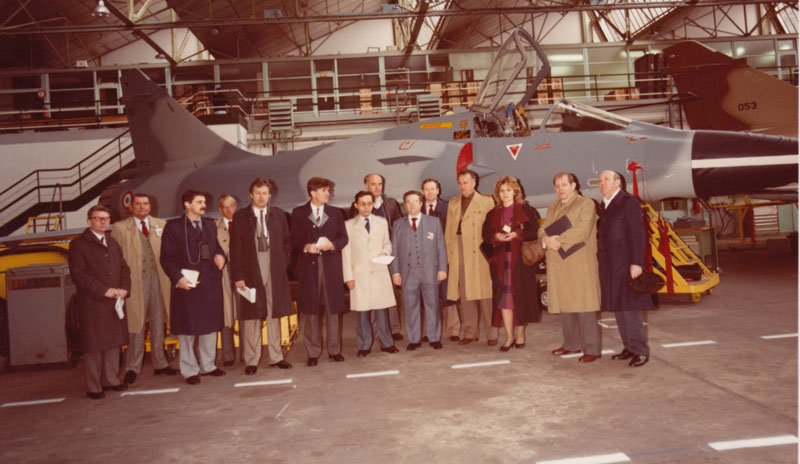
Nova vizija borbenog lovca
U Institutu u Žarkovu napravljen je kompromis između istraživačkih sloboda inženjera, i strogosti vazduhoplovne tehnologije. SFRJ je peta zemlja na svetu koja je proizvela električne komande
Base in the Mojave Desert
Our experts made a digital map of Yugoslavia, which was an integral part of the aircraft software. In the new plane, the pilot guided the entire flight across the screen. A YUGOSLAV supersonic plane was defined as a smart aircraft. Our experts did not have much experience in research work in the field of electronic systems. Fortunately, Yugoslavia had a critical mass of experts and laboratories at the Faculty of Electrical Engineering in Belgrade, the Mihajlo Pupin Institute in Belgrade, Iskra in Kranj, Ruda Čajavec in Banja Luka, RIZ and Ruđer Bošković in Zagreb. , in "IRC" from Sarajevo, at the Faculty of Electrical Engineering and "Electronic Industry" from Nis ... With the help of colleagues from France and Britain, they soon mastered electronics.

Already at the end of the eighties, a digital map of the SFRY was made in the laboratories of the Aeronautical Technical Institute, which was supposed to be the technological basis for integration into the computer software of airplanes. The use of the Inertial Navigation System integrated with GPS is planned for the navigation of the aircraft, where GPS is used for periodic updating of reference navigation data. At that time, from the end of the penultimate decade of the last century, GPS technology was in its infancy, and our experts followed that development.
All innovations in the field of aviation electronics were developed in the Sector of Electro-Electronic Systems of the Aeronautical Technical Institute, in which, in three departments, in 1987, over seventy young engineers worked.
One of the leading researchers and the head of the sector was Colonel Dr. Zarko Barbaric, today a university professor. He testified that the scientific and research staff at that time was mostly provided by the Faculty of Electrical Engineering in Belgrade and the Higher Aviation Military Academy. The condition for admission to this sector was the quality of the engineer and the recommendation of the professor.
- In the department for electronic systems, engineers dealt with power supply of the aircraft, voltage and current converters, electric lighting of the aircraft, control of aircraft engines and integration of non-electrical and electrical systems on the plane - explains Barbaric and adds: - Department for integration, which includes was also a laboratory for the integration of aircraft systems (LIAS), dealing with computer-indicating devices and subsystems. In this laboratory, the systems were connected in the same way as they would be in the plane and with the wiring that corresponds to the original aircraft wiring in all its characteristics.
Our interlocutor further states that the engineers in the Research and Development Department dealt with the technical and technological aspects of the electronic systems of the supersonic aircraft. According to Barbaric, these systems are based on the application of state-of-the-art computer systems for monitoring, managing and processing flight data, processing speech and image signals, generating scenes and symbols and displaying on modern optoelectronic indicators in the cabin. A special role was played by the attack-navigation system, which enabled combat operations during the day and night. The aircraft is designed to have systems for autonomous navigation, radar guidance, laser homing and night operations using thermal imaging (FLIR) image of the scene.
Following the progress in electronics, which was lightning fast at the time, young engineers from Yugoslavia paid special attention to electronic warfare systems. The supersonic plane was conceived as a multi-purpose aircraft, which would also be used for reconnaissance. Due to that, ambitiously developed domestic reconnaissance electronics in a wide range, which meant the use of the range from radio to microwave frequency.
- In the laboratories for signal processing, optoelectronics and microwave technology, researchers tested theoretical knowledge, corrected mathematical and simulation models of the system, formed knowledge bases for the attack-navigation system of the supersonic hunter - says Barbarić. The significance of these results, achieved in the late eighties of the last century, is current and they are widely used today, and we designed them 25 years ago.
Along with the development of the multi-purpose supersonic aircraft project, preparations were made for the reception and testing of the aircraft.
At that time, there were no test (later test) pilots flying on supersonic planes in the Aviation Test Center. The first to come to the VOC with such experience was pilot Branko Bilbija (now a retired general). Already then, the education of staff and the first preparations in the flying and organizational sense for the era of our supersonic aviation, which was knocking on the door, began.
Our interlocutor further says that as soon as the "eagle" plane touched the supersonic speed, the story began among the airmen that a domestic supersonic plane was being prepared. According to General Bilbija, in 1985 he was sent to America together with Colonel Walter Kutcher, to the Edwards base, in the Mojave Desert, to study how the Americans "train" their test pilots.
In March 1986, Bilbija was in France with our experts from VTI to test the "mirage". At that time, serious work began on the supersonic plane. At that time, the first experienced JNA pilot was "co-opted" into the Žarkovo team, which designed our supersonic plane.
- It was a great pleasure for me to cooperate with the team of experts from VTI Žarkovo. One of them was then a lieutenant colonel, and now General Đokić, who worked on automation and flight simulation - Bilbija remembers. With Đokić's team, we traveled to Brighton, to the Royal Aviation Institute "Singer Link Miles" - which produced flight simulators, where I first met and "flew" on the most modern flight simulator "Image 3". It is a two-dome simulator in which a flight is computer-generated in three D perspectives of each known aircraft and in which pilots fly against each other in close combat, or perform other tasks. From this simulator, we "bought" all the knowledge for our simulator, which our experts developed in Belgrade, plus elements for the cabin ("atrapa") of the future supersonic aircraft.
The "Atrapa" of the supersonic hunter, according to Bilbija, who was sitting in it and "flying", was designed so modern that he himself was surprised. Namely, the pilot's stick was placed sideways as in the F-16 cockpit. The pilot also commanded the aircraft, devices and weapons with two sticks (engine power command and control stick). This means that the pilot had the opportunity to perform most of the operations during the flight only through these commands. Displays with all flight parameters were placed in front of the pilot. Practically reclining in the reclined seat, the pilot guided the flight over the screen, and the position of his body enabled him to suffer G loads much easier.
THE HUNTER TALKS TO THE EARTH
At the end of 1986, a decision was made to procure a theodolite system from Switzerland, and a telemetry system from America. A new building of the Aviation Experimental Center was built, which houses new equipment, and of course humanity.
Branko Bilbija testifies that these two systems were practically laboratories that enabled the plane to "talk" to devices on Earth:
- Through Theodolite, we followed the flight trajectories of the plane and the lethal weapon fired from it. Through telemetry, we had the opportunity to monitor everything that happens in the aircraft in real time in the air, through the screen. The work of the pilot and the reaction of the aircraft to the commands in each segment of the flight were monitored, which is necessary when testing a new aircraft and its limit capabilities. With this kind of equipment and the people we educated, we were ready for a supersonic plane before the 1990s.
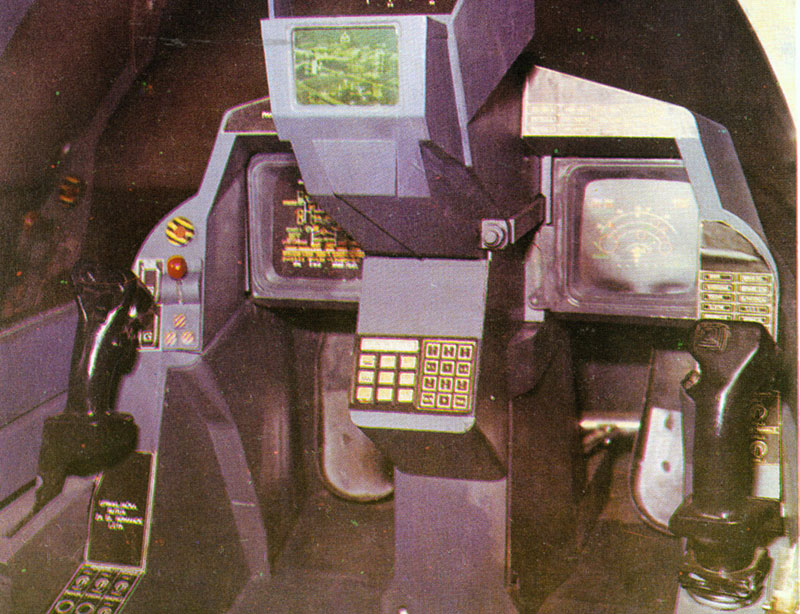
Baza u pustinji Mohave
Naši stručnjaci napravili su digitalnu mapu Jugoslavije, koja je bila sastavni deo softvera aviona. U novom avionu pilot je ceo let vodio preko ekrana
Last edited:
- Joined
- 27 December 2005
- Messages
- 16,455
- Reaction score
- 19,155
We have been developing the supersonic aircraft since 1982, we have come up with an aircraft even better than the "F-16"!
Dragan Vujicic
December 28, 2014 at 10:00 p.m.
General Savo Pustinja: Target shooting at 50 kilometers, voice piloting, were revolutionary inventions in 1990. Discontinued due to Croats and Slovenes in 1991.
WHEN in June 1991, at the Paris exhibition of the Bourges, the commander of the Yugoslav Air Force, General Zvonko Jurjevic, told partners in the French aviation industry that Yugoslavia was definitely giving up on developing and producing a multi-purpose supersonic aircraft, NA Ms. Goldstein, on behalf of The Frenchwoman was negotiating, tears were flowing. It was not easy for the Yugoslav general Sava Pustinja, the director of the "NA" program, who testified about it today for "Novosti", although he knew even earlier that the project would be put to an end.
And it all started in 1982, right after finishing work on the "eagle". At the time when the NA was suspended, hundreds of top experts were working on it. It was planned that the first five prototypes (three one - seater and two two - seater) would fly in 1995, and that serial production would begin in 1999.
For the needs of the Yugoslav Air Force, the procurement of 200 "NA" aircraft is planned for 2009. The aviation industry of the SFRY prepared personnel and technologies for production. Due to the price-quality ratio of the single-engine plane, the partners from France and England thought that it would be possible to sell up to 500 copies.
The cost of the entire project (construction of all 200 aircraft, maintenance and flying over a period of 20 years) was estimated at the then modest four billion dollars. The Yugoslav economy was supposed to create about 100,000 jobs for the needs of NA production.
About ten days ago, at a time when our public was arguing whether we had the knowledge to make an electricity meter, ie hardware and software for its operation, a two-volume Collection of Papers on 100 Years of Serbian Aviation appeared in the General Staff. In the article on the development of "NA", General Sava Pustinja, the man who led the program of this plane, writes about the state of technical intelligence in this area almost three decades ago.
THE ENGLISH CURSED LONDON
The disintegration of the SFRY in Žarkovo was not considered by experts as an option. However, according to General Pustina, near the end of the project, the British withdrew from the job, explaining that their government does not want to sell us technology that is younger than seven years. It is interesting that English experts cursed London at that time, not even knowing that it was already decided then to break up the SFRY.
Already in 1987, there was a local "Internet" at the Aeronautical Technical Institute, integrated into the then advanced American computer processor VAKS 8,700 (the only one outside Western countries). The institute networked its design capacities and laboratories, all important jobs, with optical cables. He also established an integrated system for design and research, and installed modern and powerful software. There were operational wind tunnels.
The NA test, which was conceptually designed in 1986 in cooperation with Marcel Dassault in Paris and the British company British Aerospace, showed that our aircraft is better than the American "F-16" in all 10 simulated initial combat conditions in close air combat.
For the air-ground action, the NA is planned as a rare aircraft from that time that could act on targets from a distance of 50 kilometers in the airspace.
The French company Snecma developed the "M-88Y" engine, where Y was the designation for Yugoslavia. It was then the most advanced multi-purpose engine for supersonic single-engine aircraft, for all flight modes.
The pilot's seat is designed to be tilted, so that the pilot can more easily withstand the loads in the maneuver. In the institute's laboratory, there was a simulation cockpit, which enables voice control. GPS and inertial navigation of the plane was planned even then, and the pilot had a picture of the flight and events in the air and on the visor of the helmet.
General Pustinja is 78 years old today. He retired in 1996. after all, the whole country.
- I remember when Mr. Gerard from Marcel Dassault arrived in Belgrade from Paris in 1984, who was their leading engineer in the development of advanced aircraft for a long time - says the general. - At that time, we realized that we could not make an advanced supersonic aircraft of the 4th generation on our own. We turned to the French and the English for technological support. Mr. Gerard has just retired and his last task for the French state was to assess whether the Yugoslavs have the scientific and production potential for this kind of work. At the Institute and "Sokol" in Mostar, he was satisfied with the potential and capacities we had at our disposal, and when we arrived in Trstenik in "Petoletka", he was fascinated and amazed.
- If I had died yesterday, I would not have known that there is a factory like this in the Balkans - he did not hide his enthusiasm.
EXILE EXPERTSWHEN it became clear that there was nothing from the supersonic Yugoslav plane, the army of experts lost their jobs. They traveled the world, only legends remained. When over twenty of our aeronautical engineers appeared in 1992 in Canada in a city with an extremely rich aviation industry, the mayor hosted a gala dinner: "You have come to advance our civilization," he said. For a long time in Canada, two complete football teams of our aeronautical engineers played matches against each other every week.
According to General Pustinja, in 1986, experts from our country and France, ie England, worked together in the offices in Paris and Belgrade. The conceptual design includes nine variants for a single-seater aircraft and two for a two-seater, advanced fourth generation. Earlier, the French developed their "burst" plane, on which they verified the most advanced technologies, and the NA relied on it, so the risk was reduced to a minimum.
- The cooperation between our experts with the French and the English was at the highest level - the general continues. - The head of development Marcel Dassault, Mr. Bone, came to Belgrade, he was convinced that we are on a great path. He praised our engineers who worked in Paris. How much he believed us is evidenced by the fact that I was one of the few people from all over the world who was allowed to enter the laboratories where spacecraft were tested. In Belgrade, Banja Luka, Sarajevo, Mostar, Trstenik, Pancevo ... the production of everything that was researched and designed in our Žarkovo was won. And then a breakdown happened. The agreement on the continuation of cooperation in development and production with the French was agreed and written, and all that remained was for the Presidency of the SFRY in 1989 to give its consent for signing.
- It was July of that year, terrible heat - our interlocutor remembers. - In Žarkovo, we waited for the arrival of the members of the Presidency of the SFRY, convinced that everything is under control. To our astonishment, Stane Dolanc did not even want to go upstairs during the tour while visiting the institute's facilities. Josip Vrhovec and Stane Dolanc were not interested in NA at all, which they did not even cover up.
General Pustinja also remembers the details of 1991, when Croatia seceded. Josip Vrhovec, congratulating the Croats on their "feat", emphasized his merits for their independence. He said: "If it weren't for me and Dolanc, the Chetniks would have built a supersonic plane and what would we do then ..."
The plane was supposed to be finally produced in Mostar's "Sokol", with the cooperation of a large number of Yugoslav companies.

Supersoničnu letelicu razvijali smo od 1982, smislili smo avion bolji čak od „F-16”!
General Savo Pustinja: Gađanje meta na 50 kilometara, pilotiranje glasom, bili revolucionarni izumi 1990. Prekinuli zbog Hrvata i Slovenaca 1991.
Last edited:
- Joined
- 27 December 2005
- Messages
- 16,455
- Reaction score
- 19,155
Supersonic hunter from Zharkovo
All analyzes said that the production of this aircraft in domestic plants would directly or indirectly employ over 100,000 workers.
According to the realization program, the YUGOSLAV NA supersonic plane NA was supposed to take off in 1995, and the following year, 1996, it was planned to start serial production. By 2009, exactly 200 of these planes were to be assembled in the Mostar aviation industry "Soko". This contingent was planned for the needs of the JNA, however, it was also counted on exports. Our calculations spoke of 50 aircraft for the foreign market, while the French Marcel Dassault and the English British aerospace estimated that number could be several hundred.

This optimistic assumption was based on the belief that Yugoslav designers, with the technical support of the French and British, constructed a single-engine multi-purpose, supersonic fourth-generation fighter, whose technological solutions were one step ahead or even ahead of their time. In those years, the world created "Eurofighter Typhoon" (in cooperation with European countries), "burst" (independent French project), "JAS 39 Gripen" (Swedish), Israeli project "Left" (made with the American "Gruman") and Indian LCA, which was later reformulated into "hal mejas" and which is still produced today without any special changes.
Of course, for optimism about exports, in addition to the quality of the aircraft, the price of the aircraft that was supposed to be built on the territory of the SFRY was also taken into account. The design, development and production of all five prototypes and 200 aircraft from serial production, as well as their 20-year operation, have been calculated to cost four billion dollars. Already at that time, similar fighter planes were significantly more expensive (the cheapest 25 million dollars). The purchase of the plane, its maintenance and flights for 20 years of operation would cost another 60 million per piece. The economic calculation was very clear.
The development of the Yugoslav supersonic aircraft, which was carried out by the Military Technical Institute from Žarkovo, began practically in 1982 after the completion of work on the "eagle" type aircraft. For our aviation industry, which was on the rise at the time, it was a challenge and a step forward in conquering new technologies. At the very beginning, the dilemma was resolved that our team does not have enough experience and does not have all the necessary technologies for independent development and production of such an aircraft. The document "Proposal for the development and production of a multi-purpose supersonic fighter aircraft", which passed all instances of state decision-making (Council of the Air Force and Air Defense, Collegium NGS, Collegium of the Federal Secretary for National Defense, Main Military Council SSNO and Presidency SFRY) concluded that goes into development and production with partners from abroad.
The analyzes done within the project said that the production of airplanes in domestic plants from Triglav to Gevgelija would directly or indirectly employ about 100,000 workers.
The conceptual design was done in parallel with the British and the French (British aerospace and Marcel Dassault) in as many as 11 versions. The program and implementation plan was completed in 1986. The conclusion of our experts was briefly stated that further cooperation should be started with the French company AMD-BA, since the preliminary design of this superior aircraft was realized with them. From the first contact, the French showed interest in technology transfer. It is important to note that official Paris was looking for an open opportunity for their aviation to opt for this plane. The chosen variant of the conceptual design was based on the solutions that were positively confirmed by the "Mirage 2000" and "Burst" aircraft. The latter was then in the final stages of prototype development. The risk of failure was minimized.
The results of the conceptual design and implementation program in all elements indicated the advantage of cooperation with the French company Marcel Dassault - General Dr. Sava Pustinja, who was at the head of the project, remembers these days. - Generally speaking, an improved variant of the single-engine "burst" aircraft was obtained. At the same time, the French Marcel Dassault wanted to preserve the tradition of offering the world market of single-engine and twin-engine aircraft of the fourth generation, as was the case with the "M 2000" and "M 4000".
General Pustinja explains that the conceptual solution for our NA was based on the "Canard" concept, with the French M-88 Y engine (the Y was the designation for Yugoslavia). It was a Snecma engine that was developed for a "burst", but in this case increased by about 10 percent. system integration.
- From this time distance, it is hard to believe that in the 1990s we had the knowledge and technology to rise to the world's elite - explains Pustinja. "Only" a few hundred engineers from the Military Technical Institute were not involved in the production development, but the entire Yugoslav aviation industry was behind this project, that is, the best we had, including university experts. About 7,000 people from VTI, Military Experimental Center, dedicated part of the Aviation Industry, ie "Soko" in Mostar, "Utva" from Pancevo, "Prva petoletka" in Trstenik, "Teleoptik" in Zemun, would indirectly work on the development and production of NA. Fadip ”in Becej ...
Until the launch of the supersonic aircraft project, the G-4 project, which was done before the NA, was also a world breakthrough in subsonic school-combat aviation, and all parameters said that the NA was a feasible and profitable business.
- In each phase of the adoption of solutions and the choice of technologies, comparative negotiations were conducted on their transfer to the factories of the SFRY where the plane would be made - Sava Pustinja testified. "Utva" from Pancevo, which was planned as the first subcontractor, got completely new plants with the most modern machines. New plants with new technology for the production of aircraft parts have been installed in Mostar. At the same time, generations of pilots who should accept supersonic planes in their units have been trained. The Aviation Research Center in Batajnica procured the most modern Theodolite system and Telemetry system for testing the behavior of aircraft in flight from Switzerland. The most complex aerodynamic tests were performed in the trisonic tunnel in Žarkovo.
ENTERING THE MIDDLE DEVELOPED COUNTRIES GENERAL Pustinja points out that for the purpose of making a decision, at the highest state level, to develop and produce a supersonic hunter, an expert study was conducted on the dispersion of newly adopted technological solutions to other branches of economy and industrial production. A serious group of experts concluded that mastering the latest technologies would have a huge impact on the current level of technological development of the country, and the production of supersonic aircraft should launch the SFRY in the circle of middle developed countries, according to then valid standards.
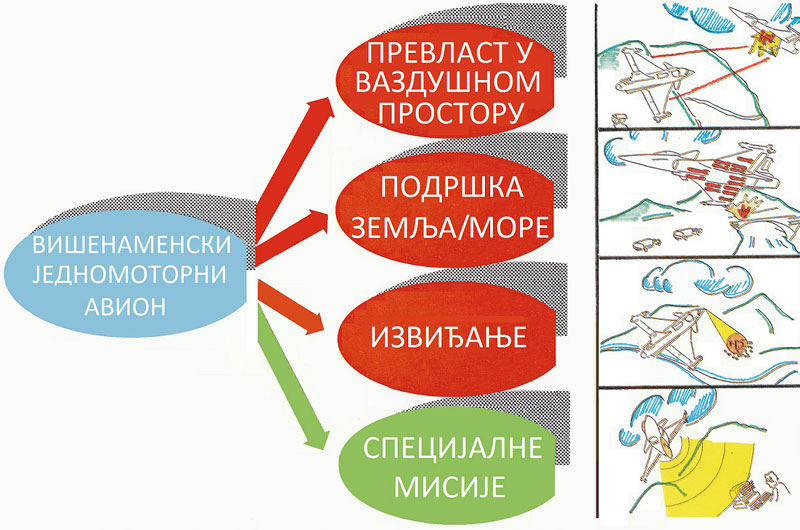
Nadzvučni lovac iz Žarkova
Sve analize su govorile da bi proizvodnja ovog aviona u domaćim pogonima direktno ili indirektno zaposlila preko 100.000 radnika
Last edited:
- Joined
- 27 December 2005
- Messages
- 16,455
- Reaction score
- 19,155
Purchasing knowledge from around the world
Dragan Vujicic
March 5, 2015 at 6:26 PM
The new plane was supposed to have an extraordinary maneuver, air-to-air missiles and radar with electronic scanning and reduced visibility.
WHEN the prototype of the twin-engine "Orao" attack aircraft took off in 1974, and especially after 1982, when its production was completely mastered, aviation strategists in Yugoslavia turned to the next stage in the development of aircraft - the fourth generation multi-role supersonic fighter.
Domestic aircraft designers were limited by the technologies available to them. The new development strategy, adopted in the early 1980s, enabled new research in the fields of new materials, propulsion, aerodynamics, electronics, computing, automation, artificial intelligence and robotics.
The fact is that in the eighties of the last century, professional journals from aero-cosmonautics regularly arrived at the address of the Aviation Technical Institute in Žarkovo from all over the world. At the time, it was a replacement for the internet. Today, when these aviation experts talk about their education through magazines, they point out that it was so dynamic then that it was enough to miss only two issues and "lose the technological step".
Also, our engineers are educated at the world's most important universities and aviation institutions from America through England to France. Moscow has not been bypassed either. There are almost no construction engineers from Serbia, from the Aeronautical Technical Institute, who participated in the design of the supersonic plane, and who did not receive additional training in any of the world's centers. Along with this trend of "supplementing knowledge and technology", there was also state military cooperation with countries that were developing their supersonic aircraft at the time.
Our political and military leadership was inclined to the idea of developing a multi-purpose fighter with one of the friendly third world countries. India, which was working on a hunter's project called LCA, was particularly interested in this. This idea fell through because our experts estimated that the Indians do not have tactical and technical requirements for the fourth generation aircraft, but an incomplete variant of the "light fighter". India has launched the development of light aircraft based on its own experience with the British GNAT. Our air force bought two GNAT planes and after detailed tests, they made the decision to buy a MiG-21.
They also contacted the Swedes, Israelis, French and British. The goal of these communications for establishing cooperation was twofold. In the first place was the idea of establishing cooperation to provide technological support, and in the second was the search for a subcontractor for the development and production of joint aircraft, which would increase the total number of aircraft in serial production, of course due to investment costs.
SEMI-SIDE VACUUM CLEANERS
DR Vojislav Šoronda explains why a solution with semi-lateral air intakes was chosen for the supersonic plane. - It is a good compromise solution in relation to the advantages and disadvantages of underbody and side air intakes in similar aircraft. We did not have an exclusive request, as the Swedes for JAS 39, that planes could land and take off from highways and autonomously from sections of highways. In such aircraft, the suction cups must be placed high to prevent suction of solid objects present on the road. Semi-side suction cups provide equally good air supply to the engine during maneuvers in the horizontal and vertical planes, and do not endanger the placement of weapons under the hull.
At the beginning of the work on the new project, Yugoslav engineers also studied in detail the Swedish program JAS 39 "Gripen". The Swedes developed it with the help and technological support of the British company "British Aerospace". According to expert notes from that time, the "Gripen" says that the American F-404 engine, which is in the class of the French M-88, was chosen for this plane, but it was an older engine, with less prospects for further development. This engine was modified for the "Gripen" and in that variant the production was transferred to Sweden. The overall "flu" technology was older and at a lower level than the programmed requirements for our NA. Our experts were convinced of that by visiting the production facilities of "British Aerospace", where the production of wings for JAS 39 prototypes took place at that time. JAS 39 wings were built in composite subassemblies, which are interconnected by classical bonding elements (rivets and screws), while for NA composite subassemblies would be interconnected then by more advanced polymerization technology and the wings would be an integral and compact structure.
In the end, the Swedes wanted to preserve their traditional independence and did not want to cooperate. That is why they did not want to participate in "Eurofighter".
Our concept was in line with the standards of the fourth generation of fighter planes. This meant an extraordinary maneuver in all flight modes, the possession of air-to-air missiles with the option "launch and forget", radar with electronic scanning and reduced visibility of the aircraft, but not to the detriment of its flight characteristics. The requirements of good maneuver included the application of reliable electrical flight commands, with which it is possible to stabilize the aerodynamically unstable aircraft. With these capabilities at its disposal, static stability was compromised throughout the flight speed range. It is predicted that the aircraft will be moderately statically unstable in the subsonic area of flight speed, which enabled static stability in supersonic mode, and the consequence of that would be good maneuvering at maximum speeds. In the fourth generation, the priority was maneuvering and agility of the aircraft, ahead of reducing visibility (unlike the fifth, where the absolute priority is "invisibility"). This required the application of the canard-delta wing aerodynamic scheme of a double arrow (trisonic), without a horizontal tail. The canard, ie the small wings next to the cabin, provided balancing of the aircraft and reduced the overall resistance, which is important, especially in maneuvering. In the fifth generation, due to the priority of "invisibility", the use of canards is avoided due to increased radar visibility.
- Two development standard airplanes of the fourth generation of that time were "Rafale" and "Eurofighter Typhoon", with two different approaches to the canard wing - remembers Dr. Vojislav Shoronda, who was working on the construction at the time. - The two surfaces with a slight canopy overhang were optimally combined on the "Rafale" and thus a current channel was obtained between the canard and the wing, which provided stability, especially at large attack angles of flight. The "Eurofighter" adopted the criterion of minimizing the induced resistance by coupling the canard and the wing, in a larger range of flight speeds, and the position of the canard in relation to the wing, the height and length of the front part of the fuselage was optimized for that criterion.
According to the testimony of this engineer, the team from Žarkovo found a compromise solution for the NA with the optimal combination of canard-wing, between these two final requirements. The intention was to work in detail with analytical and experimental methods, for which the Institute had the appropriate tools in special highly trained wind tunnels.
- The trapezoidal wing of the double boom has a good characteristic for all three phases of flight, since it was a multi-purpose aircraft, which had to have high-quality flight characteristics in all three areas of speed (subsonic, supersonic and supersonic). The only drawback was that a somewhat more complex production of such a wing was required - Dr. Shoronda testified.
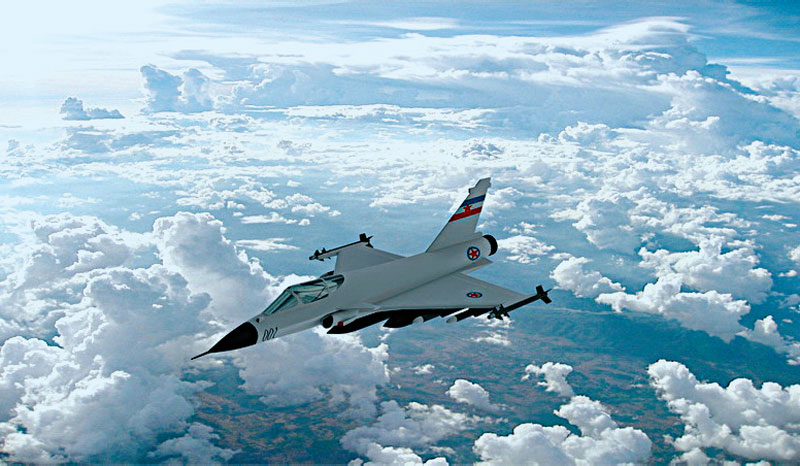
Kupovina znanja iz celog sveta
Novi avion je trebalo da ima izvanredan manevar, rakete vazduh-vazduh i radar sa elektronskim skeniranjem i smanjenu uočljivost
Last edited:
- Joined
- 8 January 2006
- Messages
- 1,605
- Reaction score
- 677
For those interested in a model kit of this aircraft, L&M Models from Croatia produces one under the Yu Supersonic name and they can be found for sale from the seller "Granicar" on Ebay at times.Vodlan offered a 1/72 scale model of Novi Avion a few years back, but they are difficult or impossible to find on the second-hand market.
- Joined
- 27 December 2005
- Messages
- 16,455
- Reaction score
- 19,155
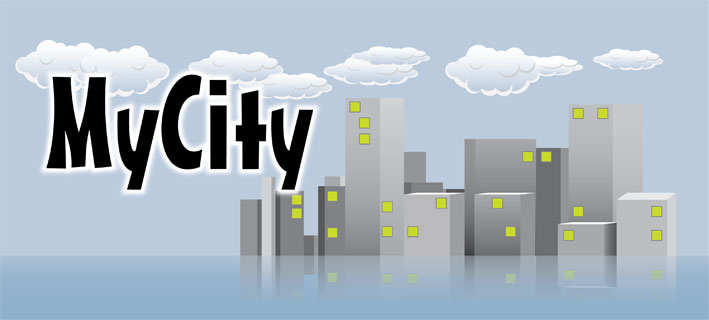
YU Supersonic
Attachments
Indeed:For those interested in a model kit of this aircraft, L&M Models from Croatia produces one under the Yu Supersonic name and they can be found for sale from the seller "Granicar" on Ebay at times.
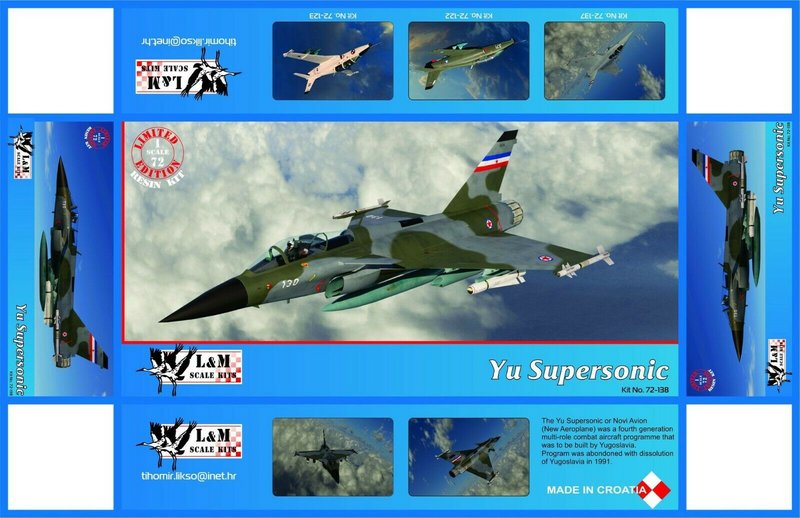
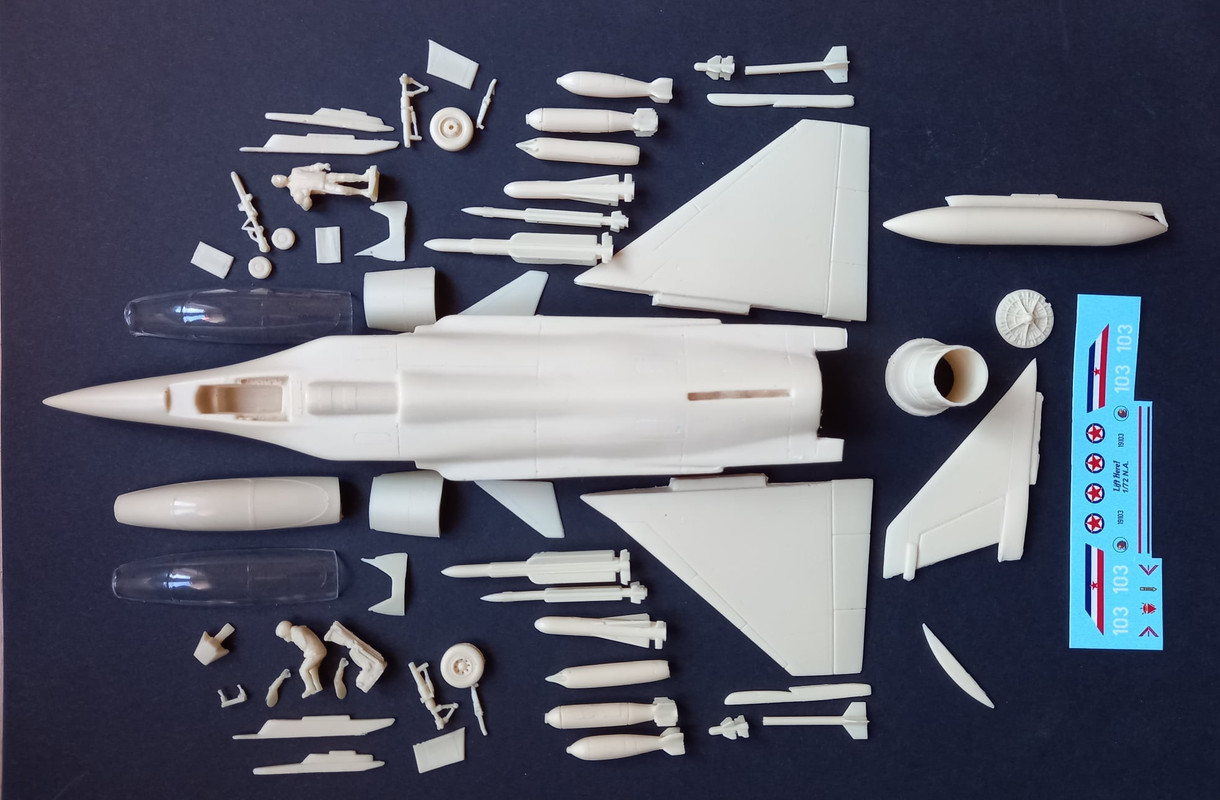
kaiserd
I really should change my personal text
- Joined
- 25 October 2013
- Messages
- 1,665
- Reaction score
- 1,616
Quick question from reading through the chain above; as far as per publicly available information how finalised was this project’s aerodynamic configuration/ design before it’s collapse?
A lot of the artwork/ artist impressions (and for-sale plastic models) as set out above appear to literally be a shrunken single-engined Rafale. That’s probably the surviving view the wider aviation world now has of this long-discontinued project.
Some of the apparent wind-tunnel models (again above) share the same general configuration but do appear to show some potential divergence re: the detailed design of the carnards, air-intakes and LERXs (and potentially others I’m not spotting).
The narrative text above doesn’t necessarily provide definitive clarity on this (but does appear to emphasise Yugoslav design input?).
What’s the educated consensus on this; literally a baby Rafale or something influenced by the Rafale and French input but with more divergence in design?
A lot of the artwork/ artist impressions (and for-sale plastic models) as set out above appear to literally be a shrunken single-engined Rafale. That’s probably the surviving view the wider aviation world now has of this long-discontinued project.
Some of the apparent wind-tunnel models (again above) share the same general configuration but do appear to show some potential divergence re: the detailed design of the carnards, air-intakes and LERXs (and potentially others I’m not spotting).
The narrative text above doesn’t necessarily provide definitive clarity on this (but does appear to emphasise Yugoslav design input?).
What’s the educated consensus on this; literally a baby Rafale or something influenced by the Rafale and French input but with more divergence in design?
- Joined
- 27 December 2005
- Messages
- 16,455
- Reaction score
- 19,155
környező országok közül Jugoszlávia a fejlesztés alatt álló Novi Avion (új repülőgép) makettjét mutatta be. Külsőleg nagyon hasonlít a francia Rafale vadászrepülőgépre, ami nem csoda, hiszen a Novi Avion fejlesztéséhez, a gép sárkányának a kialakításához a franciák segítséget nyújtanak. A makett fegyverzete két Matra Super 530 és két Mica levegő-levegó rakétából állt.
drum roll)
I asked my colleague’s brother-in-law (who was born in Hungary, but is living in Germany since the 1970s) for a translation from Hungarian to German. And I tried to translate it into English. Nothing new compared to the internet translator (it seems the first part of the sentence is missing):
- Yugoslavia (as a neighbouring country of Hungary) has shown the new aircraft “Novi Avion” which looks like the French fighter Rafale on the surface
- that’s not a surprise because it was designed with help from France
- equipped with two Matra Super 530 and two Mica AAMs
Further ‘exotic’ languages to translate 8) ?
Google Translate is now up to the job
Among the neighboring countries, Yugoslavia presented a model of the Novi Avion (new aircraft) under development. Externally, it is very similar to the French Rafale fighter jet, which is no wonder, as the French are helping to develop Novi Avion, the kite of the plane. The armament of the model consisted of two Matra Super 530s and two Mica air-to-air missiles.
F-2
ACCESS: Top Secret
- Joined
- 22 May 2020
- Messages
- 694
- Reaction score
- 1,211
I always thought that was the earlier configuration?
Deltafan
ACCESS: Top Secret
- Joined
- 8 May 2006
- Messages
- 1,574
- Reaction score
- 1,831
Yes, all the rest of the topic, and in particular posts 67 (where we see the same photo) and 68 (where it is said that the photo in question dates from the 80s) say that the version with ventral air intake was the initial version and that the version with the "Rafale" air intakes was the final version. What also seems to confirm the configuration of the "White Eagle" (2015) of post 72.I always thought that was the earlier configuration?
Last edited:
- Joined
- 8 January 2006
- Messages
- 1,605
- Reaction score
- 677
It turns out there are two different boxings of the same kit. #72-138, shown here, depicts the strike configuration in a camouflage pattern. #72-137 depicts the air superiority version in an overall light grey scheme. As hear as I can tell, the contents of both kits are identical. And, yes, I have examples of both numbers to compare.Indeed:For those interested in a model kit of this aircraft, L&M Models from Croatia produces one under the Yu Supersonic name and they can be found for sale from the seller "Granicar" on Ebay at times.


Last edited:
The second box top Evan mentioned:

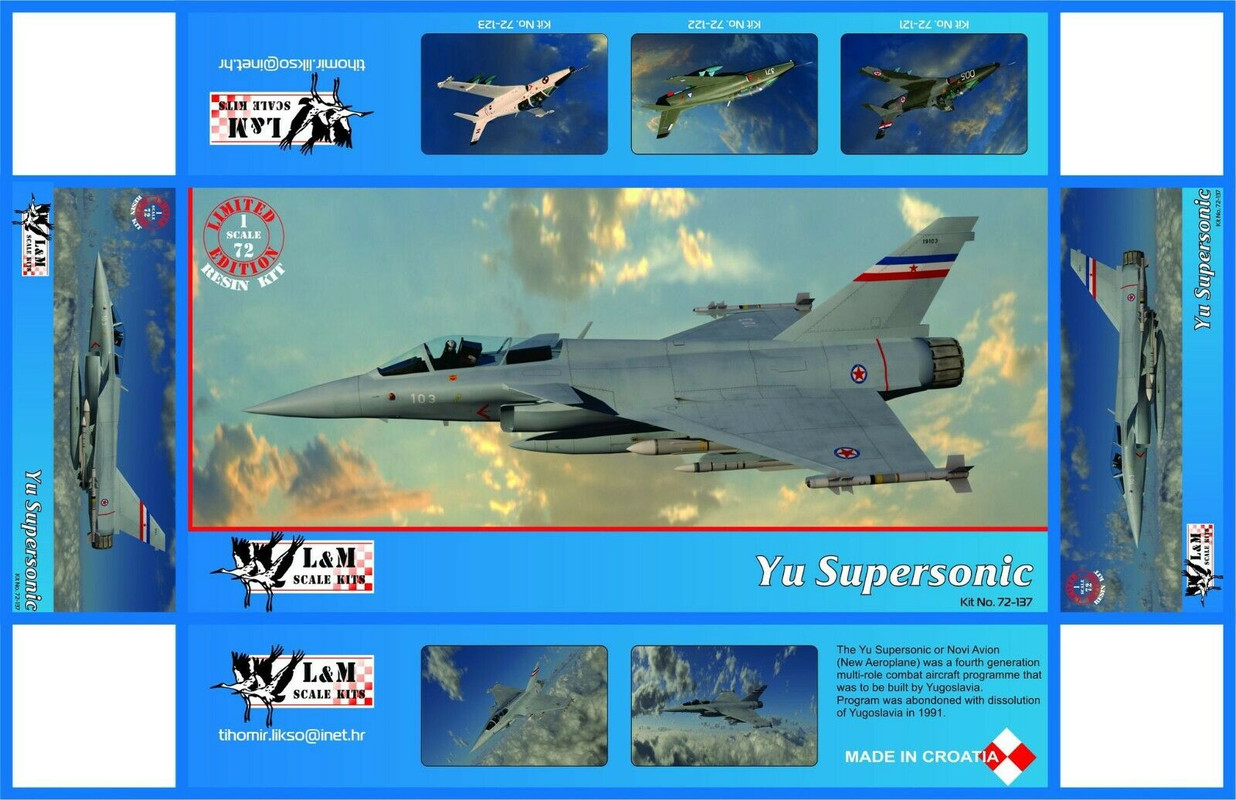
- Joined
- 8 January 2006
- Messages
- 1,605
- Reaction score
- 677
As I said, I got both of mine from Granicar (https://www.ebay.com/usr/granicar) on Ebay. They don't always have it but it's the only place I have seen it.A quick search didn't find me any places where the kit is available.
How yugoslavia thought they could afford a jet like this mistafises me, considering the difficult (putting it lightly) economic situation in the 80's (hell they whint to the imf twice!). Well this was a huge make work program, due to the middle class of yugoslavia being mostly made up of government workers, that were rapidly losing there jobs thanks to market liberalization (wich happened a lot earlier then the rest of east Europe.
But it is a good representation of the changing views of the JNA, basically the rual areas that the JNA had based there gorilla war plans had been significantly depopulated thanks to various economic policies in the 60's and 70's, especially with rural women, wich had been the back bone of the logistical support system of the partisan movement in ww2. Citys (as seen both in the yugoslave wars and in Ukraine) were now seen as the back bone of national defense. Leading to the increasing professionalization of the JNA. Unfortunately the also lead to more and more money poring into the military due to the very delicate geopolitical situation which the federal state really could not afford (not lest because the internal states more and more refused to chip in and were much more focused on improving the individual militas.
All that being said, I would be very curious on how well this plane would have held up compared to the lavi.
But it is a good representation of the changing views of the JNA, basically the rual areas that the JNA had based there gorilla war plans had been significantly depopulated thanks to various economic policies in the 60's and 70's, especially with rural women, wich had been the back bone of the logistical support system of the partisan movement in ww2. Citys (as seen both in the yugoslave wars and in Ukraine) were now seen as the back bone of national defense. Leading to the increasing professionalization of the JNA. Unfortunately the also lead to more and more money poring into the military due to the very delicate geopolitical situation which the federal state really could not afford (not lest because the internal states more and more refused to chip in and were much more focused on improving the individual militas.
All that being said, I would be very curious on how well this plane would have held up compared to the lavi.
so the idea was to make a cheap version of Rafale in Yugoslavia with help from with the French and offer it to third countries like India, Pakistan, Egypt, Iran, Iraq.Something like French technology sold to countries that are not allowed to have modern western technologyReally super interesting, could have been a good contender to first get Gripen.
Nice looking plane also, as if a Rafale and a Mirage F1 had spent a night together.
- Joined
- 25 January 2020
- Messages
- 1,075
- Reaction score
- 1,507
Did the aircraft ever begin construction? I have some friends from the region who found some sources which claimed that certain components were under construction before the project was cancelled. If there is evidence to suggest that this was truly the case, are there any photos of these parts?
- Joined
- 27 March 2006
- Messages
- 1,793
- Reaction score
- 1,309
"General Pustinja explains that the conceptual solution for our NA was based on the "Canard" concept, with the French M-88 Y engine (the Y was the designation for Yugoslavia). It was a Snecma engine that was developed for a "burst", but in this case increased by about 10 percent."
This snippet from Paul's post no95 above seems to indicate that Snecma was offering an M88 variant with 10% additional thrust increase over the vanilla M88 as found in the Rafale twin installation.
This answers a few questions for me, as I always thought the current thrust of the M88 was just a little light for single engined projects.
Edit: The M88-3 and -4 engines (increased thrust) were aimed at single engine fighters, the -3 particularly at the Gripen C. The -3 seems to mirror the M88 Y closely.
I assume then that these stemmed from the M88 Y as described above?
This snippet from Paul's post no95 above seems to indicate that Snecma was offering an M88 variant with 10% additional thrust increase over the vanilla M88 as found in the Rafale twin installation.
This answers a few questions for me, as I always thought the current thrust of the M88 was just a little light for single engined projects.
Edit: The M88-3 and -4 engines (increased thrust) were aimed at single engine fighters, the -3 particularly at the Gripen C. The -3 seems to mirror the M88 Y closely.
I assume then that these stemmed from the M88 Y as described above?
Last edited:
I only know that the made a model of what the plane's cockpit would look like be. There was some thought as to how to build the body of the aircraft whether it was a riveted composite material .On a frame like on the Swedish Gripen jas-39 but they refused that approach. although they had sent people to Sweden at the saab factory for training to work with this airframe approachDid the aircraft ever begin construction? I have some friends from the region who found some sources which claimed that certain components were under construction before the project was cancelled. If there is evidence to suggest that this was truly the case, are there any photos of these parts?
.And the second approach was to build the entire body from a composite material in one unit or on several smaller parts that will be joined
Last edited:
as I remember I think the Americans allowed, I mean the U,S congress NOVI AVIONI to have an engine from U,S origin i think it's about General Electric F404 But I mean only a limited version of f 404 or a certain number of engines but you must check this information.
- Joined
- 6 September 2006
- Messages
- 4,326
- Reaction score
- 7,506
slobanslobein
ACCESS: Restricted
- Joined
- 17 December 2020
- Messages
- 1
- Reaction score
- 1
totally wrong .. Tito was dead in 1980 just as new mig-21 bis were delivered and Milosevic although coming to power in Serbia wasnt real master of SFRJ ( Yougoslavia) .Later states of Serbia and Montenegro ( Milosevic's Yugoslavia) did now have funds nor facilities to do anything . project was officially terminated as cost cutting measure during prime minister Ante Markovic in1990 8or 1991) , besides even without that it could not go after breakup of Yugoslavia .It would now seem as if the "Novi Avion" program commenced at the end of the Tito era, and continued under the Milosevic regime - only to be ended by the collapse of Yugoslavia.
Similar threads
-
what if Dassault opted for a single engine Rafale
- Started by helmutkohl
- Replies: 41
-
1980s F-4 Phantom upgrades (BMAC, IAI, ADTAC, etc.)
- Started by Pyrrhic victory
- Replies: 6
-
Rolls-Royce Griffith Supersonic VTO Airliner
- Started by McTodd
- Replies: 43
-
What if : "Only deltas" French Air Force post Mirage III
- Started by Deltafan
- Replies: 8
-

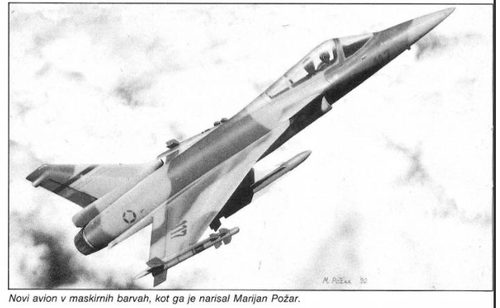
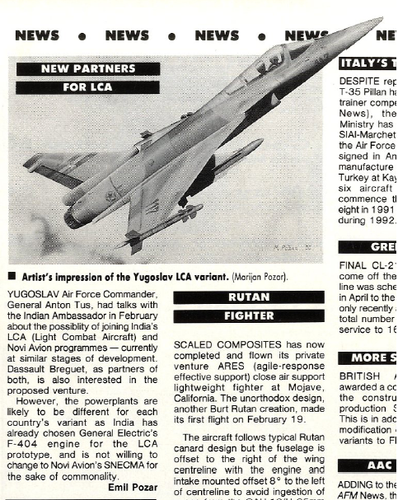
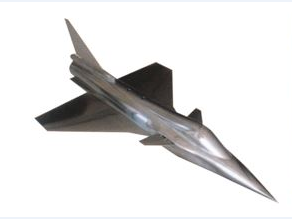
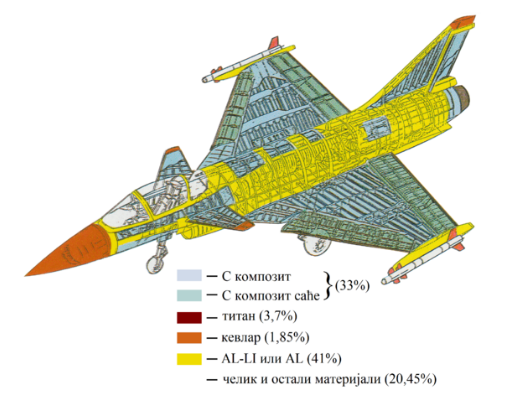
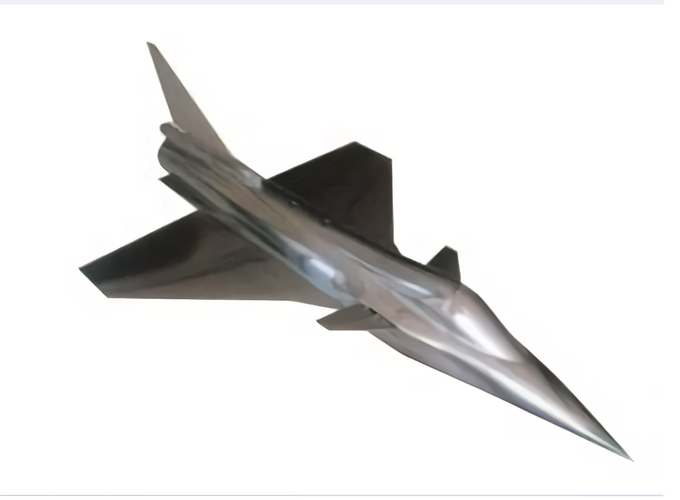
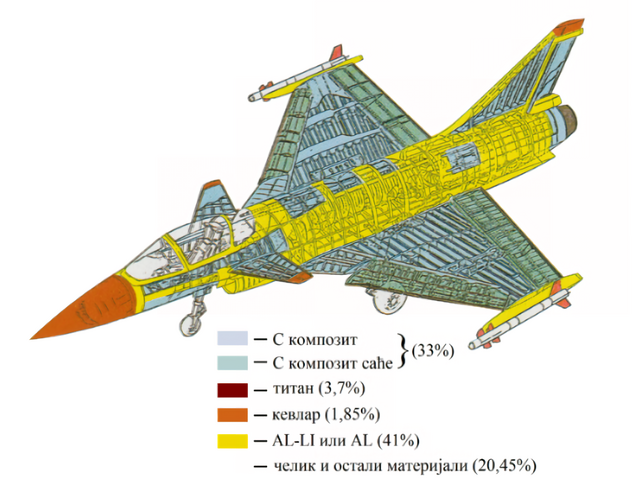
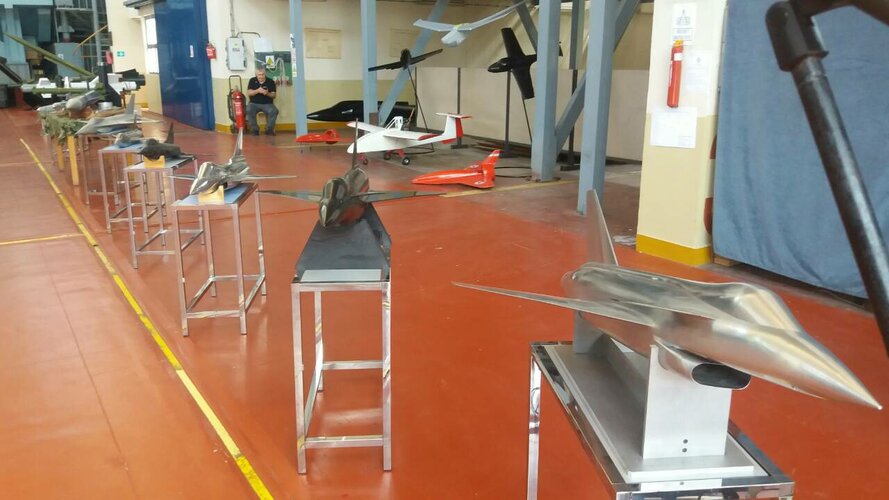
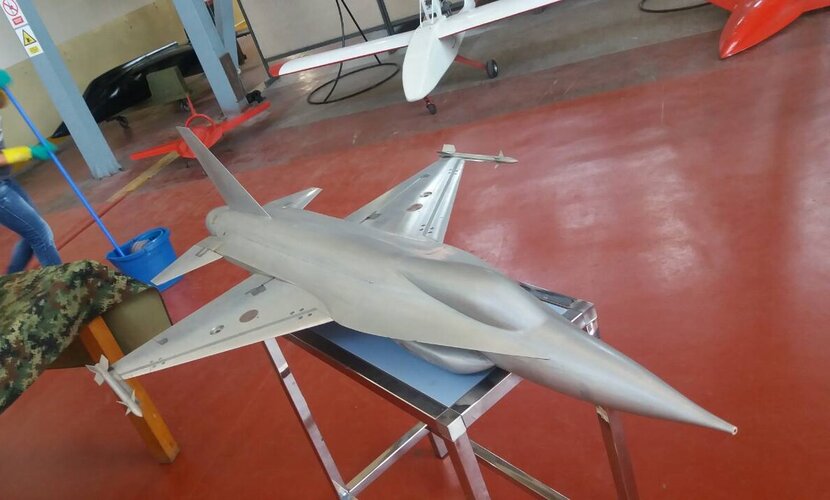
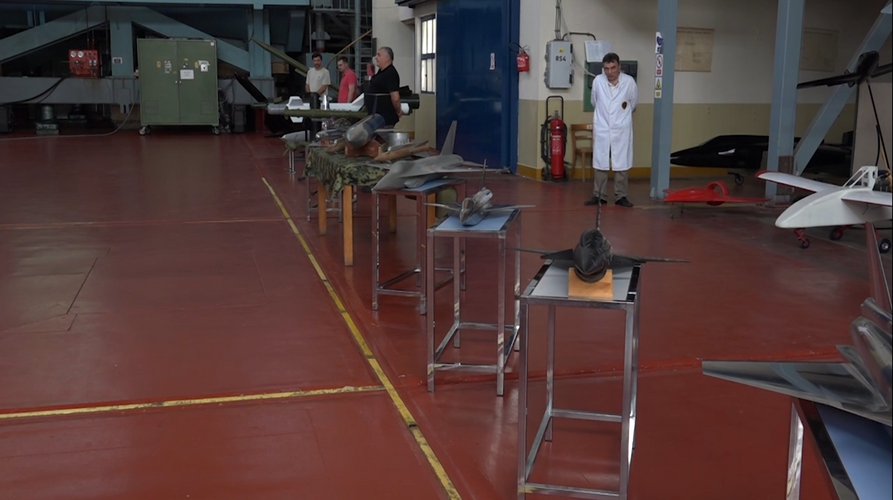
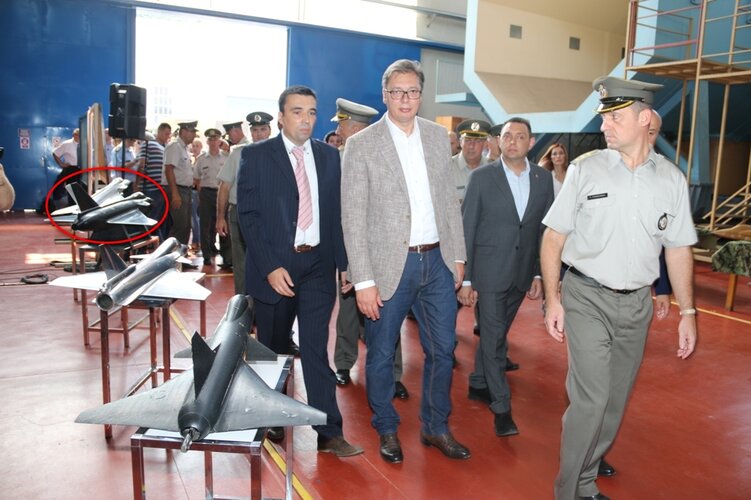
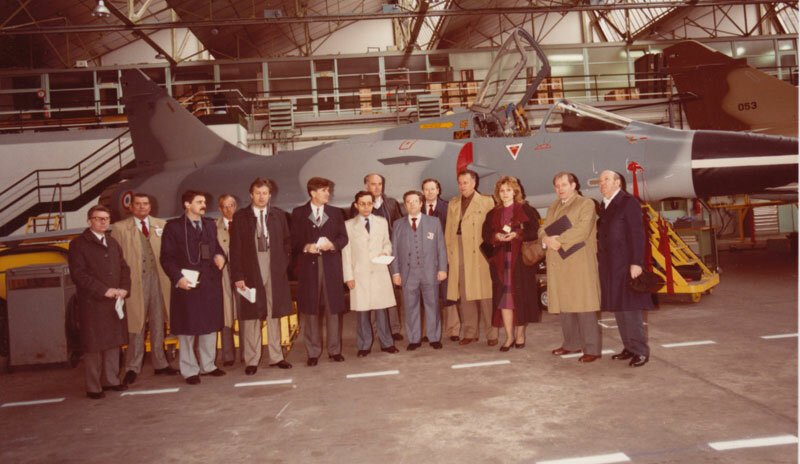
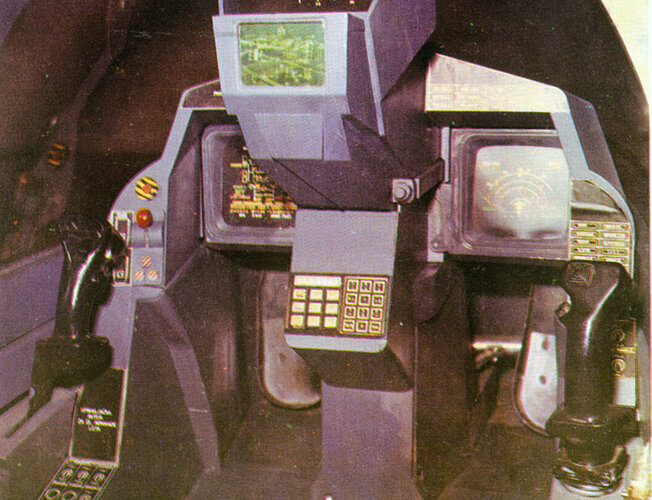
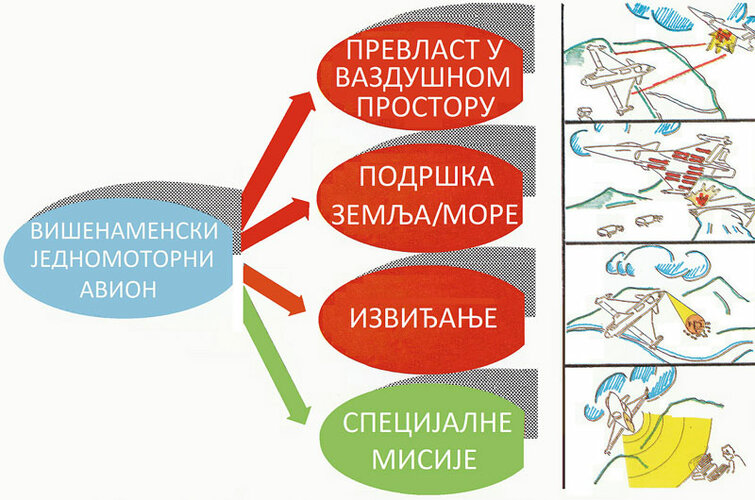
![216254_156171147_[2019.06.28_10.15.26].png](/data/attachments/212/212312-6b3288fb6fc88ce477a6a04c04d6aeb3.jpg)
